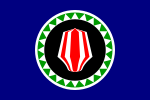| History of Bougainville |
|---|
 |
Bougainville, an autonomous region of Papua New Guinea (PNG), has been inhabited by humans for at least 29,000 years, according to artefacts found in Kilu Cave on Buka Island. The region is named after Bougainville Island, the largest island of the Solomon Islands archipelago, but also contains a number of smaller islands.
The first arrivals in Bougainville were ethnically Australo-Melanesian, related to Papuans and Aboriginal Australians. Around 3,000 years ago, Austronesians associated with the Lapita culture also settled on the islands, bringing agriculture and pottery. Present-day Bougainvilleans are descended from a mixture of the two populations, and both Austronesian and non-Austronesian languages are spoken to this day.
In 1616, Dutch explorers Willem Schouten and Jacob Le Maire became the first Europeans to sight the islands. The main island was named after French admiral Louis Antoine de Bougainville, who reached it in 1768. The German Empire placed Bougainville under a protectorate in 1886, while the remainder of the Solomon Islands became part of the British Empire in 1893. The present-day boundaries between Papua New Guinea and Solomon Islands were established by the Tripartite Convention of 1899. The incorporation of Bougainville into German New Guinea initially had little economic impact, although the associated Catholic missions succeeded in converting a majority of the islanders to Christianity.
The Australian Naval and Military Expeditionary Force (AN&MEF) occupied German New Guinea in 1914, following the outbreak of World War I. After the war's end, Bougainville and the other occupied territories were named as a League of Nations mandate, which Australia administered as the Territory of New Guinea. During World War II, the Japanese invaded and occupied Bougainville in order to support their operations elsewhere in the Pacific. The subsequent Allied campaign to reclaim the islands resulted in heavy casualties and the eventual restoration of Australian control in 1945.
In 1949, following administrative reforms by the Australian government, Bougainville was incorporated into the Territory of Papua and New Guinea. The Panguna mine was established in 1969 and soon become a source of conflict. The Bougainville independence movement established the Republic of the North Solomons in 1975, but by the following year the newly independent PNG government had re-established control. Tensions continued, and the subsequent Bougainville Civil War (1988–1998) resulted in the deaths of thousands of people, as the Bougainville Revolutionary Army sought to secure independence and was resisted by the Papua New Guinea Defence Force. A peace agreement was reached in 2001, by which it was agreed that an autonomous region would be established and an independence referendum would be held; the latter was held in 2019.
© MMXXIII Rich X Search. We shall prevail. All rights reserved. Rich X Search
